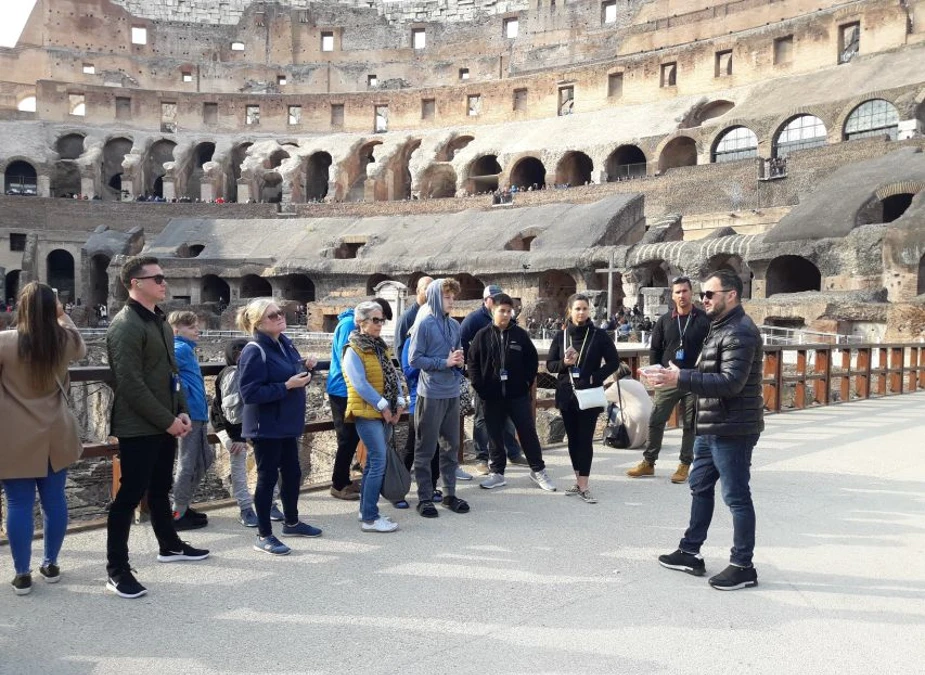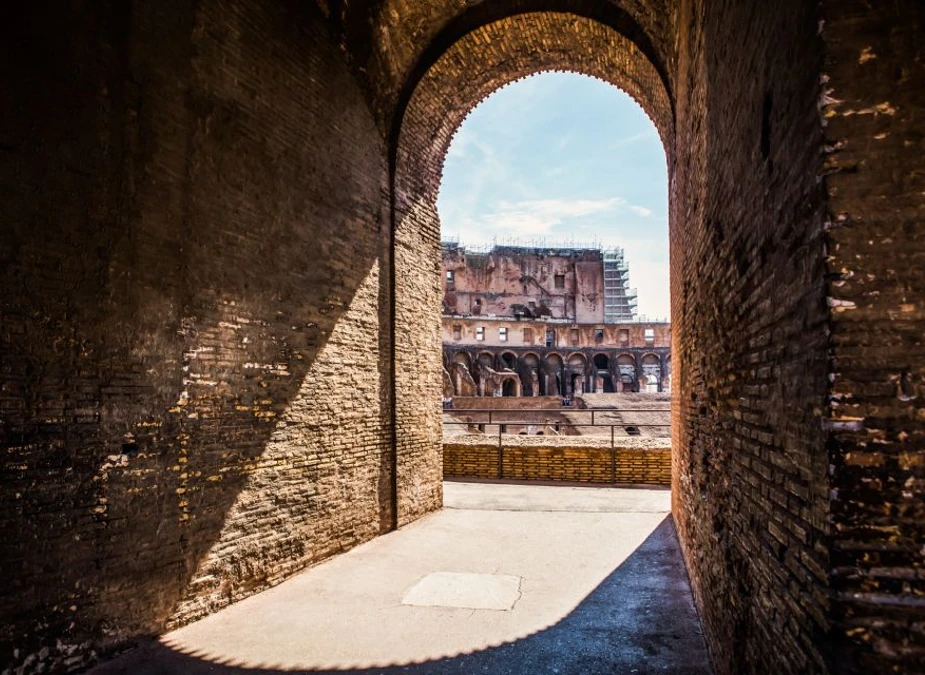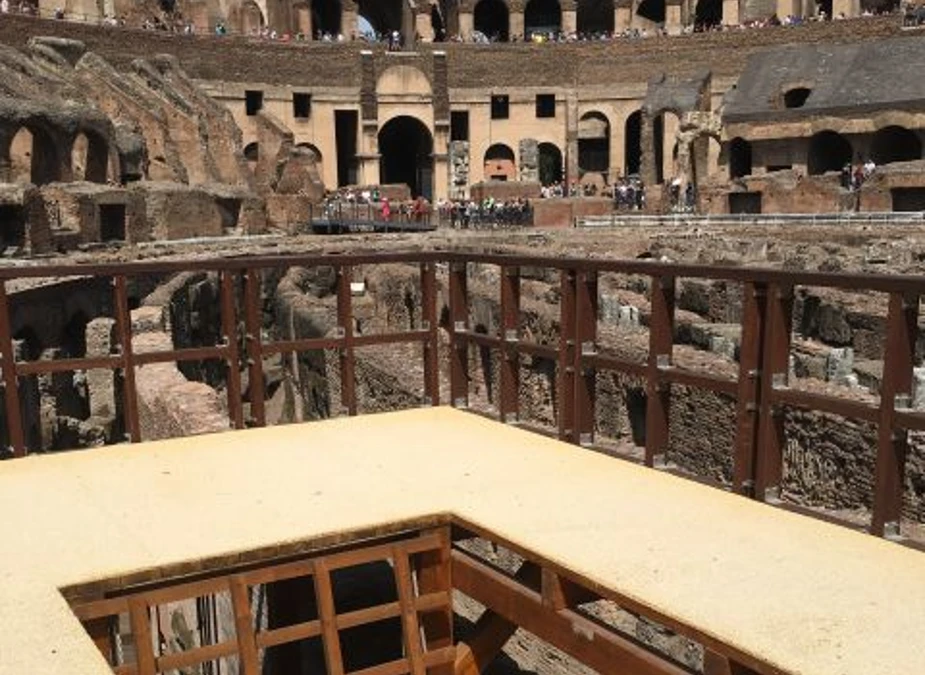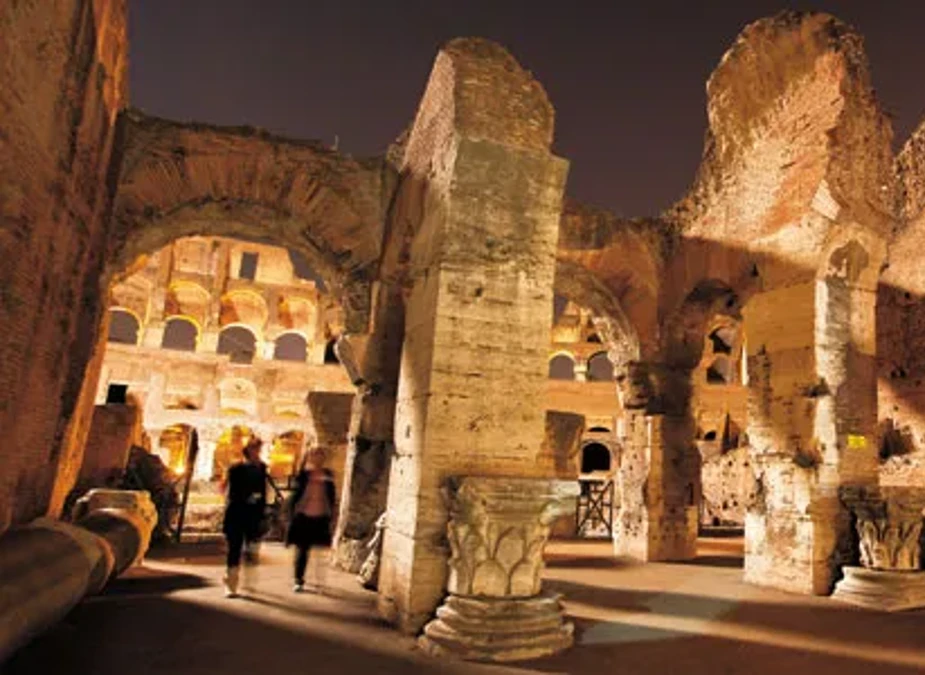Tour the Colosseum’s underworld, where history and technical wonders meet. The Hypogeum is a two-level maze of tunnels and rooms that once hosted ancient Rome’s major shows.
Witness the intricate mechanisms of trapdoors, elevators, and water systems that ushered gladiators and wild creatures onto the arena surface. Explore the underground rooms where animals were kept and gladiators trained to fight. As you explore these underground corridors, you’ll deeply appreciate the innovation and grandeur that marked the Roman Empire’s most famous Amphitheater.
Note: Get your tickets for the Colosseum Underground tour now to explore the arena’s depths and discover the gladiatorial secrets hidden beneath the floor!
How to Explore the Underground?
Exploring the Underground needs a special guided trip as it is not accessible by regular tickets. Here is how to explore the Colosseum Underground:
Buy tickets
Tickets to the Colosseum Underground are sold separately from ordinary Colosseum tickets and sometimes sell out rapidly, particularly during peak season (April to October).
Choose a Tour
There are several kinds of guided tours that are offered, such as:
- The most extensive trip, the Arena and Underground tour, gives visitors access to the Colosseum’s upper levels, the arena floor, and underground passageways.
- The Underground Focus Tour delves into the intricate system of tunnels, chambers, and elevators utilized during gladiatorial matches and animal exhibitions, with a particular emphasis on the Colosseum.
1. Underground Guided Tour

Take a guided tour of the Colosseum, which includes entry to the dungeons and gladiator arena. This tour also includes exclusive access to the limited subterranean region.
Discover the functions of this magnificent structure by exploring the Gladiator’s Arena and the Colosseum’s basements. After touring the rest of the monument, proceed toward Palatine Hill. Later, make your way to the Roman Forum by going downhill.
- Access to the Colosseum’s Gladiator’s Arena, Underground, Palatine Hill, and the Roman Forum
- Live guide in English
- Headsets to hear the guide clearly
- Skip the line through a separate entrance
- Adult (17 to 99 years): €149
- Child (2 to 16 years): €129
- Infant (Up to 1 year): €35
This ticket is non-refundable.
2. Underground and Ancient Rome Tour

With skip-the-line tickets, take an interactive tour around the areas of the Colosseum. With a guided tour to learn about the Romans and the gladiators as you explore the arena, ground floor, underground tunnels, and second tier.
Find out the history of the gladiators and untamed creatures housed in the subterranean rooms. Additionally, you will get an hour to view Palatine Hill and the Roman Forum.
- Live guide in English
- Skip-the-line entrance ticket to the Colosseum
- Access to the underground, arena, ground floor, second tier, and exhibition
- Access to Roman Forum and Palatine Hill
- Headsets to hear your guide clearly
- Adult (17 to 99 years): €139
- Child (2 to 16 years): €119
- Infant (Up to 1 year): €34
This ticket is non-refundable.
3. Exclusive Colosseum Underground Tour

Take an exclusive tour of Rome’s most popular attraction, the Colosseum, to see its arena, underground passageways, and Roman Forum. Come along with our very informed guides and take advantage of the small-group, semi-private tour experience.
Start your adventure in the Colosseum, where you can investigate its intriguing underground passageways and marvel at the magnificent arena. Proceed to the Roman Forum to fully immerse yourself in the political and social life of ancient Rome.
- Blue badge certified tour guide in English
- Colosseum entry
- Access to Colosseum underground and arena floor
- Roman Forum guided tour
- Skip the line through express security check
- The ticket accommodates a small group of up to six people.
- Adult (2 to 99 years): €159I
- nfant (Up to 1 year): Free
Cancel up to 24 hours in advance for a full refund.
The Tour Experience
To provide a more personal experience, Colosseum Underground trips are limited to a maximum fixed number of people. The tours, which usually take an hour, are given by informed guides who will go over the background and purpose of the subterranean buildings.
Historical Context
Visit the Hypogeum, Emperor Domitian’s underground marvel that enhanced the Colosseum’s shows with intricate tunnels, rooms, and cutting-edge stage equipment.
Construction
The Colosseum, ordered by Emperor Vespasian and finished by his son Titus, was built as a gesture to solidify the legitimacy of the Flavian dynasty and present spectacular shows to the citizens. Emperor Domitian later built the Hypogeum to improve the arena’s functioning and spectacle.
Purpose
The underground in Greek, the Hypogeum, was a two-level network of tunnels, chambers, and corridors beneath the Colosseum’s arena surface. This region was crucial for storing the animals, gladiators, and equipment required for the games and permitting the complicated stage technology that produced extraordinary effects.
Architectural Layout
Uncover the Hypogeum’s sophisticated two-level architecture, linking tunnels, and creative machinery that smoothly coordinated the Colosseum’s enormous displays.
Structure and Design
The Hypogeum was separated into two primary levels, each with its distinct purpose.
The bottom level included the major service corridors and storage sections, while the top level housed more specialized chambers for storing animals and training gladiators for their performances.
The structure was constructed of stone and wood, with intricate mechanics and elevators transporting animals and scenery to the above arena.
Tunnels and Passageways
A network of tunnels and passages connected several holding areas to the main arena.
These tunnels were precisely engineered to allow for the swift and efficient movement of performers and animals, guaranteeing that the shows above could run smoothly.
Some tunnels went beyond the Colosseum, linking to surrounding buildings like the Ludus Magnus, the primary gladiatorial training facility.
Engineering Marvels
View the Colosseum’s engineering wonders, including complex elevators, trapdoors, and water systems that synchronized ancient Roman plays.
Lift and Elevator
The lifts and elevators, driven by human and animal labor, transported animals and stage equipment to the arena floor. The lifts used a complicated system of pulleys, counterweights, and winches to introduce animals and gladiators quickly and dramatically into the arena.
Trap Doors and Special Effects
The arena floor included several trapdoors that could be opened to allow for unexpected appearances and disappearances. These trapdoors are connected to the hypogeum by vertical shafts, enabling animals and props to be hoisted or lowered.
Water Management Systems
The Hypogeum featured advanced water management systems with channels and cisterns to control flooding and mechanisms to rapidly flood and drain the arena for mock naval battles, known as naumachiae.
Uncover Colosseum!
Book curated experiences handpicked by our world-trusted partners.
Functionality and Logistics
See the busy logistics of the Colosseum’s Hypogeum, where animals and gladiators were methodically prepared for big performances.
Preparation for Games
The Hypogeum was a bustle of activity in the days before the games. Animals were sent from throughout the empire, and gladiators were trained to fight.
Trainers, handlers, and other workers worked feverishly to prepare for the day’s activities.
The logistical constraints of organizing such a diverse group of artists and animals were enormous, demanding exact scheduling and coordination.
Housing And Maintenance of Animals
One of the Hypogeum’s principal tasks was to shelter and care for the numerous animals in the games. These featured lions, tigers, bears, elephants, and other exotic animals.
The animals were housed in isolated holding chambers to keep them quiet and safe.
Handlers were responsible for feeding and caring for the animals and preparing them for their performances in the arena.
Gladiator Quarters
The Hypogeum also housed gladiators frequently confined in isolation before their contests.
These halls allowed the gladiators to prepare psychologically and physically for their confrontations.
Trainers and doctors were available to help with any last-minute preparations or injuries.
Hypogeum’s Role in Spectacles
Learn about the Hypogeum’s critical role in Colosseum shows, including thrilling animal hunts, dramatic gladiatorial combats, and naval warfare.
Animal Hunting (Venation)

Venation, or animal hunts, were prominent parts of the games. These instances demonstrated the skill of hunters and the savagery of wild creatures. The Hypogeum was vital in these performances since trapdoors and elevators released animals into the arena. The unexpected emergence of wild creatures provided a sense of danger and thrill to the hunt.
Gladiatorial combat
Gladiatorial fighting was the centerpiece of the Colosseum’s activities. The Hypogeum was a staging ground for these contests, with gladiators waiting below before making theatrical entrances. The lifts and elevators made for quick and unexpected debuts, enhancing the intensity of the battles.
Executions and Public Penalties

The Colosseum also hosted public executions and penalties. The Hypogeum made these events possible by providing safe holding quarters for captives and a practical transfer method to the arena floor. These terrible exhibitions were designed to dissuade crime and revolt.
Mock naval battles
One of the most remarkable uses of the Hypogeum was to stage simulated naval battles, known as naumachiae. By flooding the arena, the Romans recreated legendary sea battles replete with ships and fighters. The architecture necessary to flood and drain the arena demonstrated Roman creativity and introduced a new dimension to the Colosseum’s capabilities.
The Hypogeum in Modern Times

Look into the Colosseum’s Hypogeum, a unique combination of history and engineering that inspires you via tours, media, and cultural intrigue.
Educational And Touristic Significance
The Hypogeum is an essential feature of the Colosseum’s visitor experience today. Guided tours let you explore the underground rooms while learning about the engineering and logistics that enabled the historic displays. These excursions give you a better grasp of Roman history and the sophistication of their public entertainment.
Cultural Impact
The Hypogeum continues to capture people’s imaginations worldwide. It represents Roman engineering brilliance and the grandeur of ancient shows. The legends of gladiators and wild animal hunts have endured throughout history, demonstrating the complicated interplay between entertainment, politics, and society in ancient Rome.
Modern Media and Pop Culture
Modern media and popular culture have fueled people’s interest in the Colosseum and its Hypogeum. Films, television programs, and literature frequently depict the Colosseum’s huge spectacles, emphasizing the events’ dramatic and sometimes horrific aspects. These depictions have served to preserve the Colosseum’s heritage and subterranean magnificence alive in modern times.
Colosseum Underground Hidden Myths
Despite its historical record, the Colosseum Underground has inspired several exciting stories and legends over the centuries:
- There is a saying that underground passages and tunnels underneath the Colosseum connect to strange places across ancient Rome, but no substantial proof has been discovered.
- Rumors about secret jewels buried beneath the Colosseum inspire occasional clandestine efforts to retrieve long-lost Roman riches.
- Certain traditions suggest that the underworld contains precious treasures or objects endowed with supernatural powers and guarded by invisible beings.
- Some believe the subterranean has an energy imprint of the extreme emotions and brutality observed during the games, influencing individuals to explore its depths.
- It is thought that friendly spirits guard the Colosseum, preserving its preservation and guiding people who value its historical significance.
Vacatis Tips for Visiting Colosseum Underground
- The Underground is a popular attraction. To avoid peak crowds, arrange an early morning ticket or evening period.
- The attraction can be cold and moist. Wear comfortable closed-toe shoes with adequate grip on uneven surfaces. Layers are also an excellent idea.
- The underground chambers offer excellent acoustics. Listen to your guide’s voice and ask them to speak out if necessary.
- Look for drainage channels, animal prints, or wear and tear on the floor that indicate the hectic activity that formerly occurred here.
- Inquire with your tour guide about the everyday life of gladiators, animal care, and the logistics of operating such a large business.
FAQs
1. Are there any myths or legends associated with the Colosseum Underground?
Legends of gladiator ghosts and monsters wandering the tunnels and trap doors leading to hell add to the Colosseum Underground’s ominous atmosphere.
2. What is the significance of the Hypogeum in Roman entertainment?
The Hypogeum of the Colosseum housed the antique stage apparatus. This underground network housed gladiators and animals, and elevators and trapdoors provided spectacular entrances and surprises. It was the invisible motor that drove Rome’s exciting entertainment.
3. Are there any interactive exhibits or displays during the Colosseum Underground tour?
While the Colosseum Underground tour concentrates on the physical ruins and your guide’s commentary, other tours will include virtual reality experiences to help visitors envision the past.
4. Can I see the arena floor from the underground area?
No, when touring the Colosseum Underground, you will not have a direct view of the arena floor above.
5. What is the difference between the Colosseum Underground and regular tours?
Regular trips go over the Colosseum’s spectator seating sections. Underground trips take you inside the subterranean rooms where gladiators trained, animals were housed, and stage machinery functioned, providing a unique glimpse into the arena’s inner workings.
Featured Image : Canva



